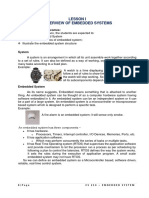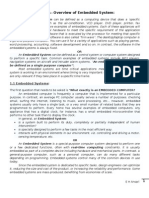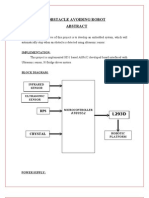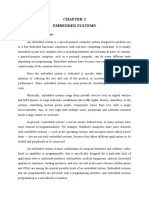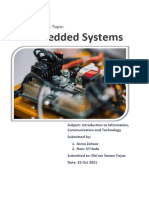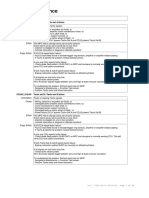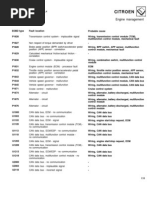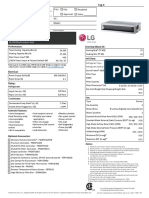Chapter-one: Introduction to Embedded Systems
1.1. Introduction
We are living in the embedded world. You are surrounded with many embedded products and your
daily life largely depends on the proper functioning of these gadgets. Television, Radio, CD player of
your Living room, washing machine or Microwave Oven in your kitchen, card Readers,, access
controllers, palm devices of your work space enable you to do many of your tasks very effectively.
Continuing advances in system software and hardware components now present exciting opportunities
in building embedded systems for applications ranging from embedded control, multimedia,
networking and information and biomedical appliances. During 2007, microprocessor manufacturers sold
on the order of 100 million processors for use as computer CPUs. In comparison, during the same time frame,
microprocessor manufacturers sold more than 3 billion embedded processors, primarily consisting of 32-bit, 16-
bit, 8-bit, and 4-bit devices. The tremendous number of applications for embedded computing has given rise to
high demand for engineers with experience in designing and implementing embedded systems.
Embedded microprocessor and micro-controller systems are the data analysis and processing technology
"backbone" of many industries-automotive, military and aerospace, manufacturing and production,
transportation, and consumer electronics-to name a few. Continuing advances in system software and hardware
components now present exciting opportunities in building embedded systems for applications ranging from
embedded control, multimedia, networking and information and biomedical appliances. Building these systems,
particularly for highly integrated micro-electronic technologies and mobile applications, presents a challenge at
every of level abstraction from gate-level designs to complex runtime systems.
Therefore, embedded systems are involved in almost every facet of modern life. All modern luxury equipments
like Digital Cameras, Mobile Phones, GPS Devices, Cars, Bikes, Televisions, DVD Players, Video Games,
Pagers, PDAs, Answering Machines, Microwave Ovens, Network Routers, Fax Machines, Music Synthesizers,
Planes, Spacecraft, and Boats are some of the examples of Embedded Systems. The Boeing 777 aircraft
contains over 1,200 processors and more than 4 million lines of software!
Late model cars may contain as many as 65 embedded microprocessors, controlling such tasks as antilock
braking, climate control, engine control, audio system control, airbag deployment etc.
Logic analyzers and digital storage oscilloscopes utilize embedded processors to support real-time operation.
1
�Even PCs, which are designed around powerful CPUs such as the Intel Pentium 4, contain embedded systems.
Floppy and hard disk drives, CD-RW and DVD-ROM drives, and external peripherals such as printers,
scanners, and other SCSI, USB, or IEEE 1394 devices all contain embedded processors.
The tremendous number of applications for embedded computing has given rise to high demand for engineers
with experience in designing and implementing embedded systems.
Even with a detailed technical knowledge in a specific technology area that make up an embedded system, a
good system design would require understanding of the design tradeoffs across choice in technologies that make
up the system.
1.1.1 What is an Embedded System?
Computing systems are everywhere. Most of us think of desktop computers such as PC’s, Laptops, Servers. …
where we associate the word computer. But there are another type of computing system which are more
common called embedded computing systems.
The embedded system is wide and varied, and it is difficult to exact definitions or descriptions. But to have
some picture let’s have the following definitions:
An embedded system is a special-purpose computer system which resides inside the device or
equipment it manages or controls.
They are devices used to control, monitor or assist the operation of equipment, machinery or plant. “Embedded”
reflects the fact that they are an integral part of the system. In many cases, their “embeddedness” may be such
that their presence is far from obvious to the casual observer.
Institute of Electrical Engineers (IEE)
“An embedded system is a special-purpose computer system designed to perform one or a few dedicated
functions, often with real-time computing constraints. It is usually embedded as part of a complete device
including hardware and mechanical parts. In contrast, a general-purpose computer, such as a personal computer,
can do many different tasks depending on programming. Embedded systems control many of the common
devices in use today.”
-- Wikipedia
A precise definition of embedded systems is not easy. Simply stated, all computing systems other than general
purpose computer (with monitor, keyboard, etc.) are embedded systems.
2
�An embedded system is a system that has software embedded into hardware, which makes a system dedicated
for an application (s) or specific part of an application or product or part of a larger system. It processes a fixed
set of pre-programmed instructions to control electromechanical equipment which may be part of an even larger
system (not a computer with keyboard, display, etc).
An embedded system is designed to perform a dedicated function.
Most embedded devices are primarily designed for one specific function. Devices such as personal
data assistant (PDA)/cell phone hybrids, which are embedded systems designed to be able to do a
variety of primary functions. Digital TVs include interactive applications that perform a wide variety
of general functions unrelated to the "TV" function but just as important, such as e-mail, web
browsing, and games.
An embedded system is a computer system with higher quality and reliability requirements than other types
of computer systems.
Some families of embedded devices have a very high threshold of quality and reliability requirements.
Examples are, a car's engine controller crashes while driving on a busy freeway or a critical medical
device malfunctions during surgery, very serious problems result. Embedded devices, such as TVs,
games, and cell phones, in which a malfunction is an inconvenience but not usually a life-threatening
situation.
The wide spectrum of embedded system devices is that there is no single definition reflecting them all.
Block diagram of a typical embedded system is shown in fig.
The word Embedded System refers to “A Computer (similar to Desktop or Laptop) which has been
designed to do specialized tasks (unlike Desktop or Laptop) ”. A desktop is designed to serve as a
general purpose computer - it can perform a variety of functions (can act as a music system, as a
business machine, as a software development platform etc.). Whereas, an embedded system is
3
�designed for only a specific functionality (e.g. a Vending machine, or Media Player or a Printer). The
resources (memory and processor bandwidth) are tightly constrained in an embedded system. Also the
software which runs in embedded system generally has a close control over the system hardware.
An embedded system is a computer system with a dedicated function within a larger mechanical or
electrical system, often with real-time computing constraints. It is embedded as part of a complete
device often including hardware and mechanical parts.
1.1.2 History
In the earliest years of computers in 1930 – 40s, computers were sometimes dedicated to a single purpose task.
One of the first recognizably modern embedded system was the Apollo Guidance Computer, developed by
Charles Stark Draper at the MIT Instrumentation Laboratory. Since these early applications in the 1960s,
embedded systems have come down in price and there has been a dramatic rise in processing power and
functionality. The first microprocessor for example, the Intel 4004 was designed for calculators and other small
systems but still required many external memory and support chips.
By the mid-1980s, most of the common previously external system components had been integrated into the
same chip as the processor and this modern form of the microcontroller allowed an even more widespread use,
which by the end of the decade were the norm rather than the exception for almost all electronics devices.
1.2 Embedded systems Characteristics
Special microprocessors are used in embedded systems to reduce cost for mass production. These
microprocessors have simplified architecture, low performance and low cost comparing to general-
4
�purpose processors such as the Intel Pentium. For example, a standard 10MHz microprocessor used in
embedded systems may cost around $1. Besides, an embedded system incorporates only the minimal
amount of memory (RAM and ROM). While a desktop PC may have hundreds of megabytes of RAM
and gigabytes of ROM (hard drive or DVD), a low-cost embedded system usually have just a few
kilobytes of memory. Embedded systems are designed to operate for years without crashes, data loss
and user intervention. Moving mechanical parts such as a CD drive or a hard drive are replaced with
solid-state parts such as flash memory.
The program instructions written for embedded systems are referred to as firmware, and are stored in
read-only memory or Flash memory chips. They run with limited computer hardware resources: little
memory, small or non-existent keyboard or screen.
Following are a few of the more common descriptions or characteristics of an embedded system:
a. Embedded systems are designed to do some specific task, rather than be a general-purpose
computer for multiple tasks. That is, embedded systems are application specific & single
functioned; application is known apriori, the programs are executed repeatedly.
Special-purpose
• Typically, is designed to execute a single program, repeatedly
• It used to be single-purpose
• Now, multi-functioned, but single-purpose
• Tactic and Strategy
b. Embedded systems are not always standalone devices. Many embedded systems consist of small,
computerized parts within a larger device that serves a more general purpose.
c. Some embedded systems may have low or no performance requirements, allowing the system
hardware to be simplified to reduce costs. So here, Efficiency is of paramount importance for
5
� embedded systems. They are optimized for energy, code size, execution time, weight &
dimensions, and cost.
d. Embedded systems are typically designed to meet real time constraints that must be met, for
reasons such as safety and usability; a real time system reacts to stimuli from the controlled
object/ operator within the time interval dictated by the environment. For real time systems, right
answers arriving too late (or even too early) are wrong.
e. Embedded systems often interact (sense, manipulate & communicate) with external world
through sensors and actuators and hence are typically reactive systems; a reactive system is in
continual interaction with the environment and executes at a pace determined by that
environment.
Reactive and real-time
• Reactive: Continually reacts to changes in the system’s environment or external events
• Real-time: Must compute certain results in real-time without delay
f. Tightly constrained
a. Low cost
b. Simple systems
c. Fewer components based/small
d. Performs functions fast enough
e. Minimum power
6
�g. Hardware and software co-exist
The software written for embedded systems is often called firmware. It is stored in read-only
memory or Flash memory chips rather than a disk drive.
h. They generally have minimal or no user interface.
1.3 Embedded System Components/Elements
HARDWARE
a. Processor: Processor (or CPU) is responsible for performing all the computational and logical
operations in an Embedded Systems. Some processors (called micro-processors) also have
(limited) Memory and few peripherals integrated on the same chip.
b. Memory: Memory is a device which can be used to store data (or instructions) in a system. An
Embedded System can have on-chip (fabricated inside the microprocessor), or off-chip Memory
(or Both). There are different kinds of memory devices.
c. User Interface: User Interface is a mechanism through which user can provide certain choices to
the Embedded System. These choices are used by the CPU to perform a given task in certain
manner. Keypad is one of the most common UI. Embedded systems range from no user interface
at all, in systems dedicated only to one task, to complex graphical user interfaces that resemble
modern computer desktop operating systems. Simple embedded devices use buttons, LEDs,
graphic or character LCDs with a simple menu system.
More sophisticated devices which use a graphical screen with touch sensing or screen-edge
buttons provide flexibility while minimizing space used: the meaning of the buttons can change
7
� with the screen, and selection involves the natural behavior of pointing at what's desired.
Handheld systems often have a screen with a "joystick button" for a pointing device.
Some systems provide user interface remotely with the help of a serial (e.g. RS-232, USB, I²C,
etc.) or network (e.g. Ethernet) connection. This approach gives several advantages: extends the
capabilities of embedded system, avoids the cost of a display, simplifies BSP and allows one to
build a rich user interface on the PC. A good example of this is the combination of an embedded
web server running on an embedded device (such as an IP camera) or a network router. The user
interface is displayed in a web browser on a PC connected to the device, therefore needing no
software to be installed.
d. Displays: Displays are used to provide certain information to the User. Alphanumeric Displays
and LCD Displays are widely used in embedded device. These displays generally provide the
“User Menu” and “System Status& #8221; to the User.
e. Input/Output : I/O peripherals provide a physical media (channel) for Data Transfer with the
external (external to the system) world.
f. Other Electrical Components: There are plenty of other active and passive components in an
Embedded System. Examples include Power Supply, Data Converters, Electric Filters etc.
SOFTWARE
a. Control Software: Control Software (also known as firmware) is responsible for managing
(and synchronizing) different modules of the system.
b. Computation Extensive Software: Computational Software is responsible for performing
Mathematical and Logical Operations on the Input Data. The output of this processing can
either be sent back (to another system), or stored (in systems memory) for later use, or can be
used by the control software to take certain decisions (and do further processing based on these
decisions).
c. Device Drivers: Device Drivers are Software Modules which control System's Peripheral.
d. User Interface: This software is responsible for collecting user inputs (from input devices like
keypad or touch screen) and providing “User Menu” or “System Status” to the User (through
Display Devices)
e. Operating System (optional): Operating System is software which manages the different
resources (CPU, Memory, Peripherals) of a system and provides a abstraction of the underlying
hardware to the Users. Application developers can develop their applications (to be run on the
8
� Operating System) without having to learn much about the underlying Hardware. Operating
System is optional in Embedded Systems (unlike Desktop environment where it is the most
essential software).
1.4 Embedded Applications
In modern world, embedded systems have become an indispensable part of our life. Use of embedded
systems has become so common in our day to day life that every one of us uses them (no matter if we
are aware or not):
Embedded systems are commonly found in consumer, cooking, industrial, automotive, medical,
commercial and military applications.
A. Automobiles: Automobiles, electric vehicles, and hybrid vehicles increasingly use embedded
systems to maximize efficiency and reduce pollution. Other automotive safety systems include
anti-lock braking system (ABS), Electronic Stability Control (ESC/ESP), traction control (TCS),
automatic four-wheel drive, Fuel Injection control (for fuel efficiency), Air bags and Automatic
braking (for safety), and car entertainment systems are example of embedded systems.
B. Medical Electronics: Many sophisticated medical instruments (Body Scanners, Heart rate
monitors, Pacemaker etc) are example of embedded systems.
Medical equipment uses embedded systems for vital signs monitoring, electronic stethoscopes for
amplifying sounds, and various medical imaging (PET, SPECT, CT, MRI) for non-invasive
internal inspections. Embedded systems within medical equipment are often powered by industrial
computers.
C. Industrial Control: such as CNC machines are example embedded systems.
D. Business Applications: Vending machines, scanners, printers.
E. Household appliances: include embedded systems to provide flexibility, efficiency and features
such as microwave ovens, washing machines and dishwashers.
F. Consumer Electronics: personal digital assistants (PDAs), mp3 players, mobile phones,
videogame consoles, digital cameras, DVD players, GPS receivers, and printers. That is,
Cameras, Toys, Cellular Phones, Washing Machines etc.
G. Avionics Airplanes, Satellite Stations
9
�H. Defense: RADARs, SONARs (for suvellience), Guided Missile Systems are example of embedded
system technology.
I. Communication: Telecommunications systems employ numerous embedded systems from
telephone switches for the network to cell phones at the end-user. Computer networking uses
dedicated routers and network bridges to route data. Telecommunication, Communication satellite,
Data communication, Internet appliances etc are some examples.
J. Embedded multi-media systems form a subclass of embedded systems. (High and Mid end)
Cellular Phones, Portable Media Players, MP3 (or Audio) players, Gaming Consoles, Mid and
High End Cellular phones are examples of Embedded Multi-media. They require special
processors called “Digital Signal Processors (DSP)” for the computation extensive processing.
Summarized Examples of application of Embedded Systems
• Air conditioner • Home security System • Printer
• ATM machine • Mobile phone • Router
• Battery charger • Modem • Scanner
• Digital camera • Navigation system • TV
• DVD player • PDA • Video game console
• Fax machine • Photocopier • Wearable compute
10





